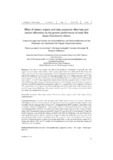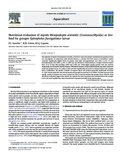Search
Now showing items 1-10 of 1258
Journal: Japan Agricultural Research Quarterly
Growth pattern of the tropical sea cucumber, Holothuria scabra, under captivity
(Ministry of Tropical Agricultural Research Centre, 2014)
The growth of the juvenile sea cucumber, Holothuria scabra, was studied under captivity to elucidate the growth variation pattern and determine the best-fit growth model to estimate age- and size-specific growth rates. ...
Journal: Silliman Journal
Seasonal changes and coliform load of Jalaur river, province of Iloilo, Panay island, Philippines
(Silliman University, 2010)
Determination of the presence/absence of coliforms as the pollution indicator bacteria, total coliform count (TCC) and fecal coliform counts specifically Echerichia coli were carried out on specific sampling points in ...
Journal: Aquaculture
Evaluation of organic and inorganic fertilizers in brackishwater milkfish ponds
(Elsevier, 1989)
The study was conducted in twelve 144-m<sup>2</sup> ponds to evaluate the effect of different organic and inorganic fertilizers on the growth, survival, gross production, and profitability of marketable milkfish. The ...
Journal: Bulletin of Fish Biology
Effect of dietary organic acid salts, potassium diformate and sodium diformate on the growth performance of male Nile tilapia Oreochromis niloticus
(Verlag Natur & Wissenschaft, 2011)
The effect of two organic acid salts on the production performance of juvenile male Nile tilapia Oreochromis niloticus were studied in two separate experiments. In the first trial the fish (initial size: 7.84kg) were fed ...
Journal: Microbiology Resource Announcements
Draft genome sequence of multidrug-resistant Vibrio parahaemolyticus strain PH698, infecting penaeid shrimp in the Philippines
(American Society for Microbiology, 2019-11-21)
The emergence of multidrug-resistant bacterial strains in diverse settings has been reported globally. In the Philippine shrimp aquaculture industry, antibiotics are used for the treatment of bacterial diseases during the ...
Journal: Journal of Applied Ichthyology
Diet composition, feed preferences and mouth morphology of early stage silver therapon (Leiopotherapon plumbeus, Kner 1864) larvae reared in outdoor tanks
(Wiley, 2015)
This study examined the diet composition, feeding preferences, and mouth morphology of the silver therapon (Leiopotherapon plumbeus, Kner 1864) larvae under captive conditions. Larvae were reared in outdoor tanks (4 ...
Journal: Aquaculture
Nutritional evaluation of mysids Mesopodopsis orientalis (Crustacea:Mysida) as live food for grouper Epinephelus fuscoguttatus larvae
(Elsevier, 2010)
The potential of mysids Mesopodopsis orientalis as live food source for grouper Epinephelus fuscoguttatus larvae was investigated. In comparison with Artemia biomass, a common live food source in larviculture, mysids ...
Journal: Asian Journal of Biodiversity
Plankton diversity in ballast water of an inter-island passenger-cargo ship calling the Philippine ports
(Liceo Press, 2014)
Numerous studies have been conducted on ballast water species composition and diversity in other countries but not in the Philippines. Thus, this study aimed to provide baseline information on the plankton diversity in ...
Journal: Ichthyological Research
Embryonic and larval development of hatchery-reared silver therapon Leiopotherapon plumbeus (Perciformes: Terapontidae)
(Springer Verlag, 2016)
The embryonic and larval development of hatchery-reared silver therapon Leiopotherapon plumbeus are described to provide essential information on the early life history of this species. Egg size, larval size at hatching, ...
Journal: Aquaculture
The length-weight relationship, food habits and condition factor of wild juvenile milkfish in Sri Lanka
(Elsevier, 1986)
Wild juvenile milkfish (Chanos chanos) were obtained from Negombo lagoon in September 1984. Thirty-one specimens (92–186 mm FL) had a fork length-body weight relationship of log W = −5.6083 + 3.2598 log L. These fish were ...











